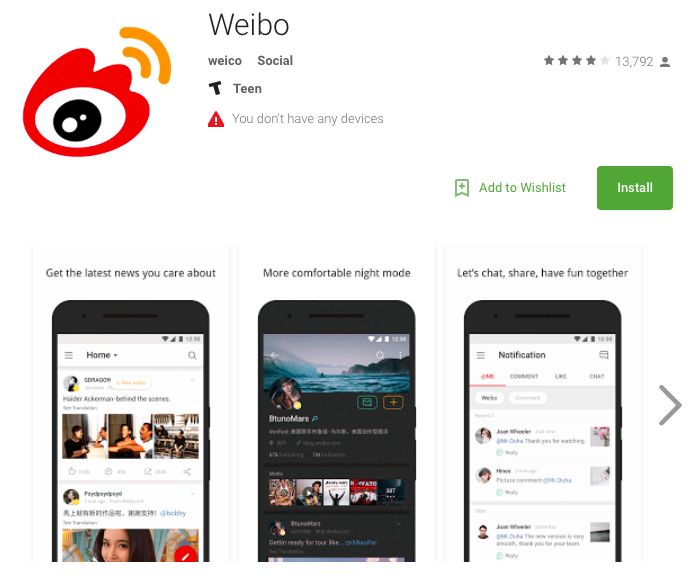Earlier this month, Tencent became the first Chinese tech giant to be valued at over US$500 billion. This ranked the company, which owns the popular messaging service WeChat, ahead of Facebook. Tencent’s new status means that it’s now world’s fifth most valuable tech company (based on market value), behind Apple, Alphabet (Google), Microsoft and Amazon.
As the creative agency We Are Social has shown, China is home to some of the world’s largest social and messaging networks. Yet outside of the region, often little is known about these platforms.
Chinese social networks and messaging apps are hubs for innovation, featuring a range of video, news, e-commerce and other services. Here is what you need to know about China’s social media landscape.
Three to watch
In China, three of the hottest social media platforms are WeChat, QQ and Weibo.
WeChat is an instant messaging app with nearly 500 million active users in China. “Half of the country’s mobile phone users will access the app in 2017,” reports eMarketer. Globally, usage is estimated anywhere between 730 million active social media users, according to Huileng Tan from CNBC, and 846 million, according to Hootsuite and We Are Social. Whatever the figure, these are large numbers, making the platform too big to ignore.

QQ launched 18 years ago and for years it was the largest social app in China, only getting surpassed by WeChat last winter. QQ recently rebranded itself to focus on entertainment and subcultures among China’s youth, with features similar to Snapchat, Rita Liao from Technode explains.
Weibo is often called China’s Twitter. However, in terms of pure numbers, the network appears to have overtaken Twitter, with 340 million active users to Twitter’s 328 million. One key reason for this growth has been the evolution of the service into to a multimedia blogging platform, with features similar to those found on Twitter, Pinterest and Tumblr combined, explains Yue Wang from Forbes. The move has resulted in an increase in younger users over the last year, according to Kantar’s China Social Media Impact Report 2017.
Five trends to watch
Service apps - Reviewing apps like Dianping and Ctrip have some of the largest satisfaction ratings in China, according to the Kantar report. Dianping, formed by the merger of two smaller companies akin to Groupon and Yelp, allows users to make lunch reservations, order food and buy movie tickets through the app, explains Sherisse Pham from CNN.
Social live streaming - Interactive features such as danmaku, where other people's thoughts appear to fly across your video screen, have ignited the launch of a social media component to livestreaming, reports Social Brand Watch. One of these apps, Mango TV, a video app launched by Hunan Satellite, is quickly growing among young users, Kantar noted.
Social news - These interactive features are also gaining popularity among news apps. The increasingly growing app Toutiao, for example, aggregates news and features live Q&As.
eSports -The esports market in China is expected to grow to US$1.26 billion in 2017, according to a new report from market researcher Niko Partners. Tencent is also reportedly committing US$15 billion to the genre over the next years.
Apps targeting the elderly - Globally, older age groups are increasingly the source for social media growth, and this is true in China, as users ages 60 and older grew by 38.2 percent last year. This group tends to see social media as a way to connect with friends and family members. In contrast, younger generations see social media as a way to relieve real life pressure, Kantar observed.
Social media’s impact
Overall, Kantar’s research suggests that the majority of Chinese people believe social media has had a positive impact. Female users, in particular, noted that social channels are helpful in making purchasing decisions, relieving pressure and enhancing self-confidence.
Despite their popularity, usage of these channels is not without its tensions.
In August, the BBC reported that China's Cyberspace Administration had accused users of the apps of violating the country’s cyber security laws, with users "spreading violence, terror, false rumors, pornography and other hazards to national security, public safety, social order."
Western social media sites and apps, such as Facebook, Instagram and Twitter, as well as Google, are blocked in the country. BBC reporter John Sudworth noted, “In China, posts are easily traceable through registered phone numbers and most people already know well the topics and opinions to steer clear of.”
Although operating in a very different political and cultural climate than Silicon Valley, these platforms nonetheless continue to be hubs for innovation and creativity.
As brands and agencies seek to expand into China — or to reach the Chinese diaspora across the globe — they will need to better understand the intricacies of the Chinese market and many of the unique products and services within it. This, coupled with the sheer size of these networks, means that social media watchers need to keep a close eye on them, if they’re not already.
Kristin Peixotto contributed this article. A graduate of the University of Oregon’s School of Journalism and Communication, she is a strategic communicator focused on engaging publics through the power of technology. Follow her on Twitter @kpeixotto27.
Main image CC-licensed by Flickr via Sinchen.Lee.


